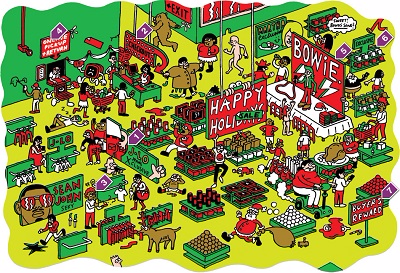We thought we’d continue our series on how operators in one of the most competitive and changing industries of all, traditional retail, are turning old business models on their heads in order to survive. Some, like Zara, the fashion empire that’s taken the world by storm but hasn’t quite made it here yet, are not just fighting back. They’re booming.
In this article:
- Why can you still see dead flies and one-armed mannequins in High Street shop windows?
- 7 ways traditional retailers are fighting back
- How Zara grew into the world’s largest fashion retailer
High Street-type retailers have been under attack for years, first from mail order operators, shopping malls, MLM schemes and discount shopping clubs, and more recently from online retailers. In Fast Company magazine’s Top 50 Most Innovative Companies of 2013, four of the top 10 are retailers, but it is significant that only one, US-based Target (no relation to Australian Target) is a conventional retailer.
It’s significant because it raises the question: What the hell are the rest of them doing? If your industry was suffering, surely you’d try anything to gain a competitive advantage over the online upstarts? Why can you still see dead flies and one-armed mannequins in the windows of High Street shops? Don’t they care if they fail?
7 ways some traditional retailers are fighting back

- By stocking Exclusive Merchandise—for example, Liz Claiborne suits at J.C. Penney or Jennifer Lopez dresses at Kohl's – brands which can't be found online.
- Lobbying the Government to Collect GST on online purchases, as they’re doing in Australia (but what are our retailers doing?), to level the playing field with online retailers like Amazon.com.
- Using Unique Barcodes on packaging to make “showrooming” – the common practice of checking out a product at a store, then buying it online – more difficult.
- Allowing Instore Pick-Up and Return for orders placed on retailers’ websites.
- Using Services and Events that make retailing more personal and are difficult to replicate online – these include measuring and tailoring (think fashion stores), instore training (think Mitre10 Mega and Bunnings), celebrity appearances, product demonstrations, cooking classes and the like.
- Rewards, Bonus and Loyalty Programmes
- Good old-fashioned service with a smile – again, this is something you won’t get from a website, but it’s something you only get consistently from retailers who genuinely care about their customers and providing great customer service.
How Zara grew into the world’s largest fashion retailer
How do you become the world’s third richest man? You found a company, Zara, which revolutionises the fashion retail world, goes on to become a global empire with more than 1,800 stores in 85 countries, and makes you enough billions to unseat Warren Buffet from the lofty position he’d held for years – that’s how.
The world’s richest man is Amancio Ortega, from northern Spain, and he got to that position by breaking the retail fashion mould. Here’s how he did it:
1. Vertical integration
Ortega was already manufacturing when he opened his first store, back in 1963. Even today, more than half of Zara’s manufacturing – their parent company makes 840 million items of clothing a year – takes place within a few hundred kilometres from company headquarters in northern Spain, in countries like Portugal and Morocco where labour costs are considerably higher than in many Asian countries. The company likes to keep its manufacturing close to home – especially its trendiest items – so design and manufacturing can be more closely aligned and they can turn around new designs more quickly – in an industry record-breaking two to three weeks – and keep stock fresh.
2. Fast Fashion
Zara was a pioneer of the concept, and they have used it to change consumer behaviour. With stores receiving deliveries of new clothes twice a week, customers know that the nifty little pencil skirt they like will be sold out in a matter of days, so they are motivated to buy now, rather than wait. It helps that prices are incredibly low, so the decision is a no-brainer. That’s changed the traditional spring and autumn fashion seasons. “Now,” says Masoud Golsorkhi, the editor of fashion and culture magazine Tank, “pretty much half of the high-end fashion companies”
— including Prada and Louis Vuitton — “make four to six collections instead of two each year. That’s absolutely because of Zara.” Nobody who was anybody would have been seen dead in fast fashion a few years ago, but now everybody – even Kate Middleton – is into it.
3. Customer Closeness
Zara only sends two or three examples of each clothing style to each of its stores. The company trains its store staff to monitor customer response to each style and report back daily to HQ, where legions of designers are standing by to come up with new designs and send them to factories to be turned into clothes.
4. Location trumps marketing
Zara doesn’t advertise, preferring instead to invest in the best possible location for their stores. Zara’s strategy is to position itself as close to Gucci, Prada and the other big names as possible. In contrast, the big names try to be as far away from Zara as possible. It doesn’t work. In 2011, Zara paid $324 million for space at 666 Fifth Avenue, New York, a building famous for being the most expensive ever sold in Manhattan, where they share an address with fashion giants Uniqlo and Hollister Co.
5. Process innovation trumps product innovation
You didn’t hear it here, but Zara has a reputation for imitating fashion rather than creating it itself. They don’t go in for fashionista and big name brands. Their in-house designers are anonymous. “They have done process innovation very well,” says Nelson Fraiman, a professor at Columbia Business School who has studied the Inditex model. “Product innovation? No.”
6. Selective Expansion
“How selective have you been when you have 1,800 stores?” you may ask. But Zara only has 45 in the United States, and the reason is that Americans tend to need bigger sizes than Europeans, which would disrupt the Zara production model, and that other European fashion companies have been burned in the US. Right now, the company has its eye on the billion-strong China market, where people fit Zara’s clothes.
7. Online-Offline Integration
Zara’s move into the web has been, uncharacteristically, a little slow, but in most countries in which the company operates, it is now possible to buy online and pick up at your nearest Zara store.
Zara’s disruptive business model reminds us of Ikea’s model – vertical integration, design led, low pricing, innovative processes – so is it any coincidence in a supposedly tough industry like retail that Ikea’s founder, Ingvar Kamprad, is also one of the richest men in the world? We think not.
Is your business model still relevant in a fast-changing world? Find out with our exclusive business model evaluation framework.
Contact us in confidence for a free Initial Consultation.
I'm Robin La Pere, no ordinary business, marketing and franchise consultant. I started my career in marketing and have worked in the property and shopping centre industries in New Zealand and Hong Kong.
Along the way I learned a thing or two about retail and over the past ten years, have been studying the impact of the internet on retail. Here are some of the things I've learned.
FREE E-BOOK:GIVE YOUR BUSINESSA NEW LEASE ON LIFE
Download Why Your Business Model is in Trouble ebook
Need to futureproof your business?
I offer these services to help you manage disruption, prevent stalling and promote innovation in your business:
- Threat and opportunity evaluation
- Business model generation
- Strategy planning
- Key business driver analysis and development
- Conference and seminar presentations
- Innovation workshop facilitation
- Business improvement
- Business re-engineering
- ‘The Disruptor’ Programme (see below)

Are you facing new or greater competition? Is your industry being disrupted? Is your business growth in danger of stalling?
The best way to predict the future is to create the future. In today's fast-changing world, it's disrupt or be disrupted. The good news is that small to medium sized businesses can be more innovative and agile than large corporations. The Disruptor Programme has been developed specifically to help SME leaders to:
- empower them with the thinking and practical skills to face change and lead a more agile and innovative business
- gain insights in how their customers see value and where opportunities exist to take advantage of this
- examine the company’s competencies and culture in order to identify opportunities to improve and innovate
To arrange a free personal Initial Consultation with me on how The Disruptor Programme can help you to futureproof your company, contact me now on +64 9 360 6063 or Skype Noordinary1262 or send me your email address and I will get back to you within 24 hours.





